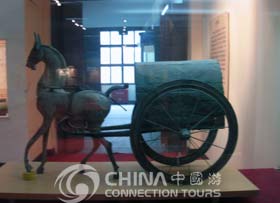 The Guizhou Provincial Museum, located at Guiyang City, is a provincial-level comprehensive museum of China. The Museum, covering a space of 19,300 square meters, was prepared in 1953 and opened to the public in 1958.
The Guizhou Provincial Museum, located at Guiyang City, is a provincial-level comprehensive museum of China. The Museum, covering a space of 19,300 square meters, was prepared in 1953 and opened to the public in 1958.
The Museum has collected over 60,000 items of relics and samples. Among the unearthed articles are the fossils of front teeth and front molar of the Tongzi Ape-man, the lower jawbone and the thighbone of the Xingyi Man, the skull and the upper and lower jawbone of the Chuandong Man; the fossils of extinct mammals and various kinds of typical stone artifacts and bone objects; and the Ge (dagger-axe, an ancient weapon), an iron sword with bronze handle, bronze Fu (a kind of cauldron used in ancient China) and bronze ding (an ancient cooking vessel with two loop handles and three or four legs) left from the Warring States Period (475-221BC), which are generally regarded as typical artifacts of that period by the academic circles. Among the artifacts are also a lacquer cup with two loop handles, a lacquer plate with inscriptions, a bronze drum with patterns, a bronze basin in the shape of salamander's body but bull's head, the Chunyu (an ancient bronze musical instrument) with the pattern of tiger on its handle, and the large-sized bronze chariot and horses, all unearthed from the tombs of the Han Dynasty (206BC-220AD) in Guizhou.
Other historical relics also include a pottery pot with the inscriptions of a long article from the year of 104, a Zhunyi Type bronze drum from the Song Dynasty (960-1279), the Unified Calendar in Wanli Regime from the Ming Dynasty (1368-1391), the Buddhist Scripture of Boloumiduo Copied by Someone in Tang Dynasty, the Collection of Letters Written by Han Qixing, the paper money printed in the Ming Dynasty and a big celadon porcelain jar from the Ming Dynasty.
The relics of minority groups are one of the key collections of the Museum. In addition to the 1,000-odd items of embroidery, wax printing, cross-stitch work, brocade and silver jewelry and ornament, the typical collections include the matrimony record of the Miao Nationality, the wine vessel painted and carved with animal patterns used by the Miao Nationality, the lady's satin lined-jacket decorated with lace and silver bells and silver pendants worn by the Miao Nationality, the dragon robe worn by the headman of the Yi Nationality, the handwritten copy of the Brief Record of Ancestors in Yi writing and the stone carving of bronze drum used by the Shui Nationality during funeral rites.
The modern and contemporary relics and revolutionary relics include the uniform worn by the uprising armies during the Taiping Heavenly Kingdom (1851-1864), a letter written by the chiefs of the Hui army refusing to surrender themselves to the Qing regime; the first notice issued by the Guizhou Temporary Government during the 1911 Revolution, the Resolution of the First Representative Assembly of the Worker-Peasant-Soldier Soviet held by the Red Army to open up the special region at the Eastern Guizhou, the Notice Issued by General Political Department of Red Army, the printing machine once used by the Red Army, and the leaflets distributed by the Red Army. In addition, the Museum has also collected quite a number of painting and calligraphy, diary and the original letters of the celebrities of Guizhou, such as Zheng Zhen and Mo Youzhi.
The basic exhibitions of the Museum include the Mineral Resources of Guizhou, the Natural Resources of Guizhou, the Peasants' Uprising Struggles of Various Nationalities in Guizhou during the Taiping Heavenly Kingdom, the Revolutionary Activities of Worker-Peasant-Soldier's Red Army in Guizhou and the Unearthed Relics from Guizhou. The Museum has also sponsored such exhibitions as the Local Conditions and Customs of Maio Nationality in Guizhou, the Rubbings of Stone Carving in Guizhou, and the Photographs of Guizhou Relics.
The Museum has also edited and published large pictorials of the Red Army's Long March in Guizhou, the Epitaph Selections of Guizhou Province, the Catalogue of Collections of Guizhou Provincial Museum as well as the Periodical of Guizhou Provincial Museum.

